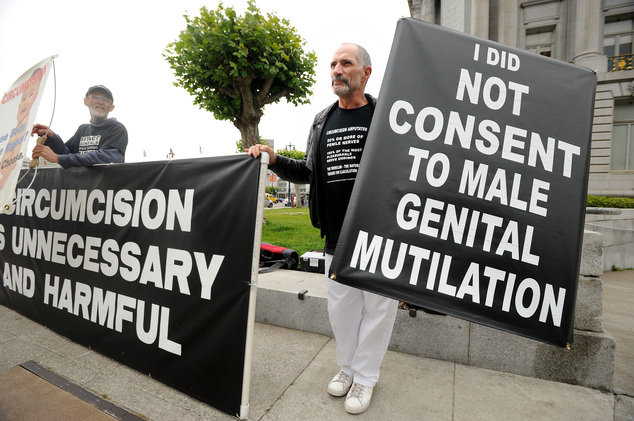Benefits of circumcision ‘outweigh the risks’ official report declares – Daily Mail
- Brief procedure involves cutting away the foreskin around tip of the penis
- Officials say it can lower a male’s risk of sexually-transmitted diseases, penile cancer and even urinary tract infections
- New guidelines released by U.S. Centers for Disease Control prevention
- Expected to draw opposition from anti-circumcision advocacy groups
By
There is clear scientific evidence that the benefits of circumcision outweigh the risks, a landmark report has declared.
A debate has long raged over the ethics of the procedure – and some men believe it has affected their sexual function or satisfaction.
But U.S. officials have now said the medical evidence supports having the procedure.
The announcement came in new long-awaited draft guidelines released by the Centers for Disease Control and Prevention (CDC).
This is the first time the U.S. Government has released such a report on circumcision, where the foreskin around the tip of the penis is cut away.

Guidelines: U.S. medical experts have declared there is now clear medical evidence to support circumcision
While the guidelines stop short of telling parents to get their newborn sons circumcised, they are very clear on the health advantages.
‘That is a personal decision that may involve religious or cultural preferences’, said the CDC’s Dr. Jonathan Mermin, who oversees the agency’s programs on HIV and other sexually transmitted diseases.
The procedure is done because germs can grow underneath the foreskin.
CDC officials say circumcision can lower a man’s risk of sexually-transmitted diseases, penile cancer and even urinary tract infections.
The new guidelines are the result of seven years of work, after a cluster of influential studies in Africa indicated circumcision might help stop spread of the AIDS virus.
‘The benefits of male circumcision have become more and more clear over the last ten years,’ said Dr Aaron Tobian, a Johns Hopkins University researcher involved in one of the African studies.
But the guidelines are important, because the rates of newborn male circumcision have been dropping, he added.
In the new guidelines, the CDC says there is now strong evidence that male circumcision can:
- Cut a man’s risk of getting HIV from an infected female partner by 50 to 60 per cent.
- Reduce their risk of genital herpes and certain strains of human papillomavirus by 30 per cent or more.
- Lower the odds of urinary tract infections during infancy, and cancer of the penis in adulthood.
Studies have not shown that circumcision will reduce an HIV-infected man’s chances of spreading the AIDS virus to women.
And research has not found circumcision to be a help in stopping spread of HIV during gay sex.
The guidelines say circumcision is safer for newborns and infants than for older males, noting the complication rate rises from 0.5 per cent in newborns to nine per cent in children ages one to nine.
Minor bleeding and pain are the most common problems, experts say.
CDC officials are recommending doctors tell parents of baby boys of the benefits and risks of circumcision – but does not detail how that information should be presented.
Because circumcision can be beneficial to men as well, the CDC says information about the procedure also should be given to sexually active uncircumcised men – especially men considered to be at higher risk of catching HIV, the report says.
However the guidelines, which the public will be able to comment on for the next 40 days, are likely to draw intense opposition from anti-circumcision advocacy groups.
‘This is a passionate issue for them and they feel strongly that circumcision is wrong,’ said Dr Douglas Diekema, a professor of pediatrics at the University of Washington.
The thinking on circumcision has swung wildly over the years.
While it has been practiced by Jews and Muslims for thousands of years, it didn’t become common in the U.S. until the 20th century.

Controversial: The new guidelines, which state how the procedure can cut risk for HIV, STDs and penile cancer, are expected to draw intense opposition from anti-circumcision advocacy groups
By one estimate, only 25 per cent of U.S. male newborns were circumcised in 1900.
It gradually became the cultural norm, and in the 1950s and 1960s surpassed 80 per cent. But then the trend reversed.
This was partly to do with changing demographics, as the U.S. population grew to include larger numbers of Mexican-Americans and other ethnic groups that didn’t traditionally circumcise their children.
Also, opposition to the procedure grew from advocates who decried the pain, bleeding and risk of infections to newborns, the Associated Press reports.
Their message was aided by the Internet and by the neutral stance of physicians groups – including, for a time, the American Academy of Pediatrics.
By 2010 the newborn circumcision rate was down to about 58 per cent, according to one CDC estimate.
But even as the circumcision rate dropped, more medical evidence came in supporting it – particularly three rigorous and influential studies in Africa that looked at the spread of HIV and other sexually transmitted diseases in circumcised and uncircumcised men and their partners.



